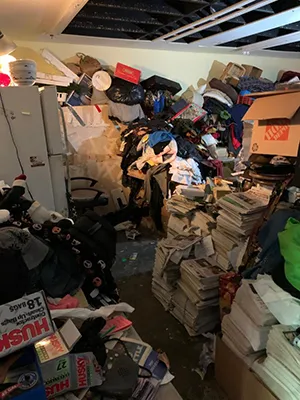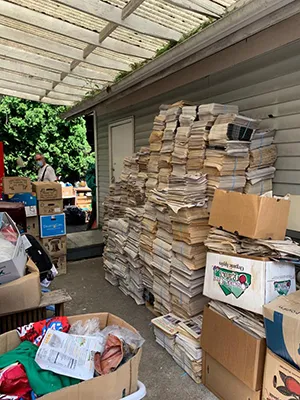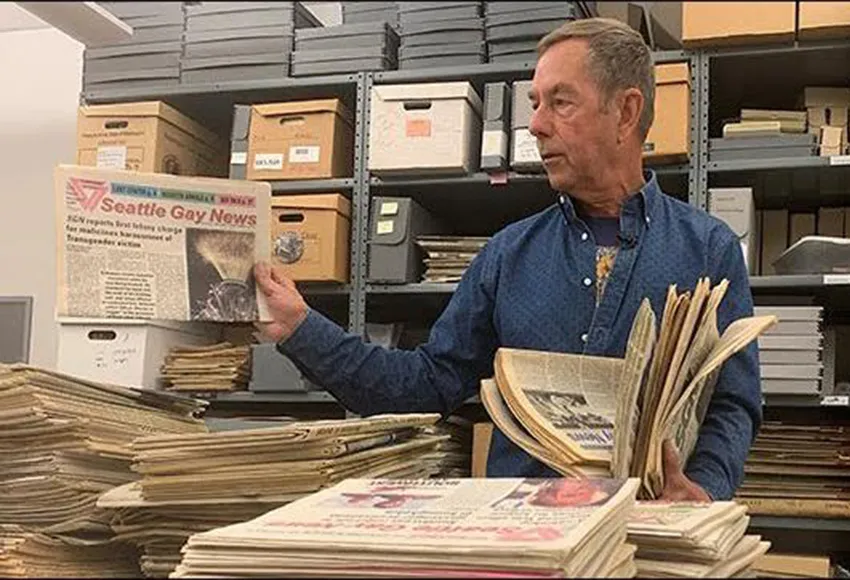One of the best ways to look back in time and learn about history is through old newspapers. They reflect current events, while also serving as future windows into the past.
But what if we didn't have that recorded history? What if each paper published just became fire kindling or kitty litter, or ended up in the recycling bin? The answer is harrowing but true – history would be lost.
It is especially heartbreaking to think of losing something that so many people fought tooth and nail to preserve, people like, George Bakan, longtime editor and owner of the Seattle Gay News.
After Bakan's passing on June 7, 2020, left the members of the Gay community in Seattle reeling, questions arose that demanded answers. One such question, posed by Marcellus Turner, executive director and chief librarian of Seattle Public Libraries at the time, was, "What's happening with the archives?"
Little did he know that this simple but loaded question would soon spur a yearlong project that would include many volunteers and countless hours.

The archive project begin
Thanks to the connection Turner made with Rick McKinnon, a longtime SGN employee and close personal friend of Bakan's, they started the archive project, complete with a team of passionate volunteers: Anna Elam, of MOHAI; Ann Frantilla, of the City of Seattle; Jessica Albano, of the University of Washington; Andrew Harbison, of the Seattle Public Library; Shawn Schollmeyer, of Washington State Libraries; Marie McCaffrey, of HistoryLink; Rosette Royale, of HistoryLink; Angela Cragin, of the Seattle Gay News; and former city councilman Tom Rasmussen.
Cragin, Bakan's daughter, who took over the SGN, was thrown into the deep end with this project but quickly learned how to swim, despite the fact that she was drowning in papers.
Because she was new to running a newspaper, was doing everything virtually (from the Tri-Cities), and was grieving all at the same time, she had no other option than to rely on others for help, people she had never met. This kind of reliance on strangers is what she referred to as "awkward and inspiring all at the same time." She said, "This group of people were a glimmer of light in such a dark time for me."
When Cragin arrived on the scene, there had been few to no organizational efforts over the 47 years since the paper was started. Copies were boxed, set aside, and forgotten. There was no central location for them: they were in storage units; in the SGN office, which Cragin described as a "real disaster"; and even in different states. Some boxes were damaged – the best-case scenario being natural wear and tear, and the worse-case being boxes and papers turned into nests and homes for rats. Tom Rasmussen called this part of the process, "The opening of Pandora's box.

Revisiting history
But what "Pandora's box" would offer would be priceless. As Rasmussen said, "To see all the complete, detailed, and chronological order of LGBTQ life in the Pacific Northwest – well, there is nothing like it."
This same feeling of the importance behind this project is something Cragin, other important coordinating figures, and the rotating group of volunteers all seemed to feel.
Steve Alexander, director of philanthropy at KUOW, got involved with this project with his husband, Michael Welke, because they believed in its mission. It also helped that they had more time on their hands due to quarantine, since this was before Alexander got the full-time position at KUOW.
Said Alexander, "As a gay man, it was amazing to see the accumulation of our history in print and in pictures." What impacted him greatly was to see the timeline of the beginning of the fight for Gay rights and visibility, in comparison to where we are today. "To see how hurt our community has been for so long, to see this fast evolution from our history of violence, death and destruction, to being a part of every family, then to see gay marriage – it was like seeing your life flash before your eyes," he reflected. This experience was so rewarding, he volunteered on six separate occasions.

Rasmussen's labor of love
For Rasmussen, this project was somewhat a labor of love. Rasmussen has been a huge supporter of the SGN since his early days in Seattle. He said, "The SGN was the only publication that reported on politics and the LGBTQ community in Seattle." When he first ran for a city council seat in 2003, the SGN was a huge supporter of his campaign.
"It was important for candidates to have the SGN's support, I think that the influence of the SGN can sometimes be underestimated," he said. "As a politician, you wanted the SGN on your side."
For the archive project, Rasmussen helped coordinate volunteers along with local librarians. He helped provide and coordinate the usage of a space in the City Hall Archives for sorting and recording
Almost done
After a year of tireless efforts, the project is on the last leg of the journey.
Excitingly, the time has now come to ship the compiled archives to various locations that requested the issues, including the Beinecke Library at Yale University, the Stonewall Library in Florida, the Washington State Library, the University of Washington, the Seattle Public Library, and the Museum of History and Industry. Of course, the SGN will have its own, in-house archive.
Not only will the physical copies find new homes all over the US but thanks to Newspaper.com, they will also be digitally archived. About the digitization, Cragin said, "That was a pipe dream at the beginning of this project. For this to be happening is extraordinary."
Because of the scope of this project, digitizing will take three years to complete.
Although this project hasn't been easy, it has and will be worth it. As Rasmussen said, "The history of LGBTQ people has not been prioritized. Doing this
To say this project was a team effort would be an understatement. Being new to the scene, Cragin was impressed, even blown away by what she witnessed. "So many people gave up their time, efforts and truly went above and beyond to help a fellow person," she said, and even described the project as a "compliment to the human spirit."
If you didn't get an opportunity to volunteer with the achieve project and you feel like you missed your chance, there is still something you can do. Although the project is pretty much completed, there are a couple missing issues (see the accompanying list) that archivists are still looking for. If you are a hoarder, now is your time to shine! Please help us find the missing pieces to this important puzzle. If you find a missing issue, please contact the SGN at [email protected].
List of missing SGN issues:
2014 – 11/28, 12/05, 12/12, 12/19 and 12/24
2011 – All of January and February
2006 – 3/10
2004 – 1/30, 3/5, 3/12, 3/19, 3/26, 5/21, 7/2, 7/9, 7/16,7/23, 7/30, 8/27,
10/1, 10/8, 10/15, 10/22, 10/29, 11/12
2003 – 9/19
1999 – 2/5, 5/28, 11/19, 12/31
1998 – 9/25, 10/23, 11/6
1997 – 1/24, 7/4
1996 – 1/12
1995 – 3/10, 6/2, 6/23 (vol. 23, iss. 25), 10/20, 12/22, 12/29
1994 – 1/14, 4/1, 6/10, 8/12, 8/19
1993 – 10/15, 12/17
1990 – 1/12, 2/9, 3/2, 3/9, 4/27, 5/18, 5/25, 6/8, 8/24, 10/26, 11/2
1989 – 5/5, 5/26, 7/14, 8/11, 10/20, 12/29
1988 – 1/1, 4/29, 6/3
1986 – 7/4, 8/29, 9/5, 9/19, 9/26, 10/17, 10/24, 12/5, 12/26
1985 – 2/25 (should be 2/1 vol. 12, iss. 5), 5/24, 7/5, 7/26, 10/18, 10/25,
11/22, 12/13, 12/20, 12/27
1984 – 4/6, 5/4, 6/15
1983 – 3/12 (vol. 10, iss. 5), 3/26, 5/27, 6/15, 7/8, 7/29, 8/12, 8/26, 9/2, 9/9,
9/16, 9/23, 10/28, 12/9
1982 – 12/7
1981 – 1/16, 2/13, 4/9, 5/8, 7/17, 7/31
1980 – 2/15, 5/9, 8/29
1979 – 5/11, 8/31
1976 – All
1975 – 3/1


